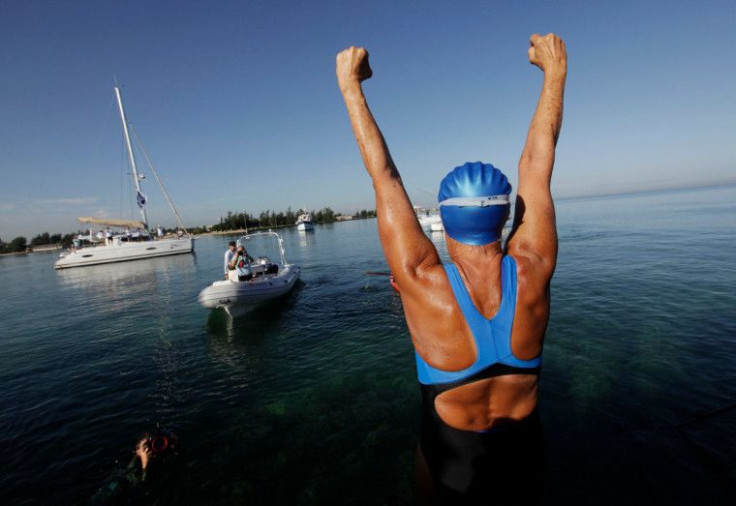Diana Nyad Completes Cuba To Florida Swim With New Anti-Jellyfish Technology

The fifth time proved the charm for long-distance swimmer Diana Nyad, who on Monday accomplished her lifeling dream of swimming from Cuba to Florida, a distance of 110 miles. On her latest attempt, the tenacious 64-year-old had a little help from new anti-jellyfish measures developed by scientists and prosthetics makers.
Australian swimmer Susie Maroney was the first person to make the watery trek in 1997 at the age of 22, but she swam within the protective confines of a shark cage. Nyad had no such protection, but she did have other anti-shark measures in place. On all of her swims, the accompanying kayakers have special sonar-emitting devices strapped to their craft that drive away sharks that come within a limited radius. Nyad’s team also keeps a shark-repelling chemical mixture tied to one of their boats.
There are also safety divers standing by to deal with sharks. As Nyad explained in a July blog post, if a shark had ever gotten dangerously close to her, the divers would have used special PVC piping to prod the animal to draw its attention away from her. They do not use guns or spears.
“We will not under any circumstances kill an animal on our crossing,” Nyad wrote.
But historically, one of the more troublesome obstacles on Nyad’s crossings has been jellyfish. In September 2011, on her third attempt to complete the swim, she had to tread water for two hours after box jellyfish stings sidelined her not long after the start; 24 hours later, the jellyfish stung again, and a weakened Nyad could no longer beat back the current with her stroke.
One of the newest pieces of equipment Nyad brought out on this Cuba-Florida swim was a specially made anti-jellyfish mask. The mask, made by Stephan Knauss and colleagues from Pasadena, Calif.-based Aesthetic Prosthetics, is made of silicone and varies in thickness around the face -- thicker around the eyes, thinner around the lips.
“We must have made about six of them before we got to the current one,” Knauss told ABC News.
While the silicone mask was a tough barrier against jellyfish, Nyad found that swimming with it could be a bit uncomfortable; in fact, the silicone caused her mouth to swell.
For more unobtrusive relief, Nyad also got some assistance from University of Hawaii researcher Angel Yanagihara, who developed a topical anti-jellyfish cream for the swimmer’s skin. Specially formulated to stay on for a long time in seawater, the cream inhibits jellyfish tentacles from discharging their stingers, as well as providing treatment for any potential stings.
Yanagihara, like Nyad, has had some close encounters of the jellyfish kind. She first started studying the venom of the box jellyfish more than a decade ago after “plowing” into a swarm of Hawaiian box jellies during one of her early-morning swims.
“I suffered horribly painful stings over much of my exposed skin, including my neck,” Yanagihara told WAMC Northeast Public Radio in February. “The fiery pain and days-long agony got my full attention. As a biochemist, I was completely intrigued, but as a sting victim, it was personal. I needed to know more.”
When the victorious Nyad arrived onshore Monday, she acknowledged the essential help of her support team, telling onlookers that while her open-water swimming treks "may look like a solitary sport, it's a team."
© Copyright IBTimes 2024. All rights reserved.





















